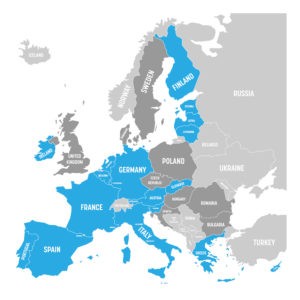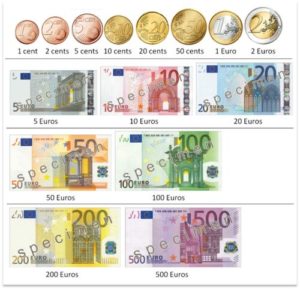Map: Currencies of Europe and the EU
Travel Tip: Buy Some Euros or Foreign Currency Before Leaving the U.S. for Europe
When making a trip to Europe, one of the important topics to consider is the whole subject of currency exchange.
When you travel to a foreign country, you must provide payment in their local currencies. If you aren’t careful, there can be so many hands in the currency exchange pot that you simply wind up getting ripped off without even knowing it until you get home.
Therefore, with foreign currency exchange, it’s buyer beware!
First off, I recommend that you read our article: 7 Currency Exchange Tips for International Travelers. This article will give you all of the basics to consider.
For this article, however, I want to suggest that you bring some foreign currency with you before you even leave the U.S.
You see, once you land in your destination, you’re going to need some cash to make your way to your ship and/or hotel. If you’re going to use a taxi service, you may well be able to use a credit card for the fare, but then you’re also going to need some small local currency for tips as you make your way to your ship’s stateroom or your hotel room.
Therefore:
- Step #1 – Click the map above to determine what types of currency you’re likely to need. The blue countries are in the Eurozone and accept the Euro. The dark gray countries are in the Eurozone but DO NOT accept the Euro. And the light gray countries are not in the Eurozone and DO NOT accept the Euro.
- Step #2 – Contemplate how long you are likely to be in the various countries. For example, if you are doing a river cruise on the Rhine or the Danube, you are going to encounter Switzerland, Hungry, and perhaps even the Czech Republic; countries who do not use the Euro. However, if you’re there for just a short period, then use your credit card to make purchases. If you find you need cash for some reason, then find a bank ATM and take out some additional cash to cover tips, etc.
- Step #3 – For most of you traveling to Europe, you’re likely going to need some Euros. Therefore, head to your local bank a few weeks before you leave and grab €200 in small denominations (5s, 10s, and 20s) to keep on hand for small purchases and tips. The smallest paper denomination in Euros is the €5 bill, so if you prefer to give smaller tips than roughly $6, then grab some €2 coins in the airport before you take off. Currency exchange booths are readily available. For the best exchange rate, we recommend that you get your Euros from your local bank. However, our local bank will not deal in coins, so the currency exchange booths in the airport are our only option for the €2 coins. If you burn through your €200 Euros while traveling, then make your way to a bank owned ATM and get yourself some more cash. We don’t recommend that you bring large amounts of cash with you when traveling.
Travel Tip: Don’t forget to let your credit and debit card issuers know that you will be traveling internationally. There’s nothing worse than having your bank’s fraud protection shut your card down while you are traveling overseas.
Benjamin Franklin said: “an ounce of prevention is worth a pound of cure.” Take our advice and purchase some of your destination’s local currency before you leave the U.S. You’ll thank me later.
If you enjoyed this article, sign up for our travel newsletter to keep abreast of our best travel tips, on-location reviews, exclusive travel offers, group travel events, and much more.

Roaming Boomers Travel Services is an Independent Affiliate of Cadence, a Virtuoso® member. CST#201120-40
 The Roaming Boomers
The Roaming Boomers






Thank you so much for sharing this. I’m planning a trip to Europe and I was not sure if all the countries use euro or have their own currency.